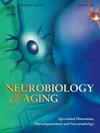Cerebral white matter hyperintensity volumes: Normative age- and sex-specific values from 15 population-based cohorts comprising 14,876 individuals
IF 3.7
3区 医学
Q2 GERIATRICS & GERONTOLOGY
引用次数: 0
Abstract
White matter hyperintensities (WMH) increase with age, with marked interindividual variation. There is a need for normative data by age and sex, to improve individualized WMH burden assessment. In this study, we pooled cross-sectional data from 15 population-based cohorts (14,876 nondemented individuals, age 18–97 years), through the Meta VCI Map consortium. Whole brain and tract-specific MRI-assessed WMH volumes were calculated in MNI-152 space. We used quantile regression to create centile curves of WMH volume versus age, stratified by sex. Total WMH volume and interindividual variance increased exponentially with age for both sexes, with females showing higher WMH volumes. WMH volume increase with aging was not uniform across the white matter, but instead followed one of three different patterns depending on location. Age- and sex-specific normative data for total and regional WMH volumes were created. Our study provides detailed information on the normal distribution of total and regional WMH volumes across adulthood. The normative data enable a quantitative approach to interpreting total and regional WMH volumes in clinical practice and research settings.
大脑白质高密度体积:来自 15 个人群队列(包括 14 876 人)的年龄和性别标准值
白质高密度(WMH)会随着年龄的增长而增加,但个体间差异明显。我们需要按年龄和性别划分的常模数据,以改进个体化的 WMH 负担评估。在这项研究中,我们通过 Meta VCI 地图联盟汇集了来自 15 个人群队列(14876 名非痴呆患者,年龄在 18-97 岁之间)的横断面数据。在 MNI-152 空间中计算了全脑和特定磁共振成像评估的 WMH 体积。我们使用量子回归法绘制了 WMH 体积与年龄的百分位曲线,并按性别进行了分层。男性和女性的WMH总体积和个体间差异均随年龄呈指数增长,女性的WMH体积更大。随着年龄的增长,白质中WMH体积的增加并不一致,而是根据位置的不同而呈现三种不同的模式。我们创建了总体积和区域 WMH 体积的年龄和性别特异性标准数据。我们的研究提供了成年期总体积和区域 WMH 体积正常分布的详细信息。有了这些标准数据,就可以在临床实践和研究环境中采用定量方法来解释总体积和区域 WMH 体积。
本文章由计算机程序翻译,如有差异,请以英文原文为准。
求助全文
约1分钟内获得全文
求助全文
来源期刊

Neurobiology of Aging
医学-老年医学
CiteScore
8.40
自引率
2.40%
发文量
225
审稿时长
67 days
期刊介绍:
Neurobiology of Aging publishes the results of studies in behavior, biochemistry, cell biology, endocrinology, molecular biology, morphology, neurology, neuropathology, pharmacology, physiology and protein chemistry in which the primary emphasis involves mechanisms of nervous system changes with age or diseases associated with age. Reviews and primary research articles are included, occasionally accompanied by open peer commentary. Letters to the Editor and brief communications are also acceptable. Brief reports of highly time-sensitive material are usually treated as rapid communications in which case editorial review is completed within six weeks and publication scheduled for the next available issue.
 求助内容:
求助内容: 应助结果提醒方式:
应助结果提醒方式:


